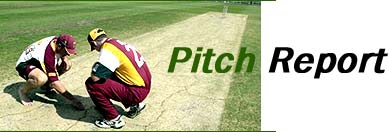Home > Cricket > Special >
Quality of the outfield
May 12, 2003

On many grounds the coverage of the outfield was still incomplete at the time of the visit. On nearly every ground the outfield grades were uniform in every direction to the boundary. Work was underway topdressing the outfield to achieve a smooth surface.
Weeds were being treated by hand weeding. The most troublesome weed is Cyperus rotundus 'purple nutsedge'
In some cases coarse grasses have established in patches.
Very little fertilizer is used on the out fields in most cases.
Regular mowing and hand weeding is successful at keeping weeds to a low level in most grounds. Only in one case was ' purple nutsedge' invasion so dense it would warrant chemical control.
Weeds appear to be introduced by soil topdressing. Some grounds are being topdressed with soil, sand and organic matter mixtures.
Thatch control will be an issue on the outfields, especially where hybrid Bermuda is planted.
Recommendations
Continue with a programme of hand weeding purple nutsedge and other weeds from the outfileds.
The issue of chemical herbicide application for purple unusedge needs to be carefully considered (Appendix 4).
I recommed that all stadiums follow a basic maintenance fertilizer programme involving applying an NPK fertilizer of 14:10:27 analysis at 150kg/ha after scarifying the outfields at the start of the monsoon. (Appendix 5).
In addition apply up to four applications of urea at 40kg/ha per application at intervals through the playing season, never less than 6 weeks apart. Where urea is applied for colour and density before an important match, it should be applied 2.4 weeks before the match so the peak growth rate is declining by the time of the match. This is a suggested minimum fertiliser programme. Some grounds already apply more fertiliser applications and use compound NPK fertilisers for most applications with good results.
The practice of applying a very heavy application of urea within a week of an important match to roduce a dark-coloured outfield should be changed. Lighter rates applied more frequently is a better practice.
Very few grounds have had a soil fertility analysis taken of the pitch or the outfield. A soil fertility analysis should be taken of the pitch and outfield (every 5 years) to check for nutrient deficiencies.
The soil analysis report should include a description of the methodology used for analysing the soil, and an interpretation of the results indicating whether the values are high, medium or low for healthy Cynodon growth. (Appendix 6).
Where low values occur the report should include recommended fertilizers needed over and above the maintenance fertilizer to raise the soil analysis values above a deficiency level.
One advantage of following a basic maintenance fertilizer programme is that in most cases fertility levels will be maintained and deficiency is unlikely to develop quickly.
Outfields are being topdressed with either soil, soil plus sand, soil plus composted organic matter (coir, a coconut fibre compost), or sand alone. Sand and organic matter is added to the soil to create a softer surface where the soil tends to become very hard when dry.
Great care needs to be taken with sand topdressing. Once a layer of sand deeper than 5mm has built up at the surface, all future outfield topdressing must only be sand or sand plus organic matter. It is not a good idea to switch back to soil topdressing as a damaging root break will be formed.
Irrigation needs to be applied regularly on sand topdressed grounds.
I recommend against mixing sand with soil. It can be a worthwhile practice when the soil itself has a high sand content, like the red soil, but a high proportion of sand is needed to make it worthwhile. Mixing sand with soil can sometiomes make the soil harder in some cases.
Mixing coir or other composted material with soil or sand is a good idea and will make the surface softer.
The best solution for the hard outfield problem is to sintall pop-up irrigation and to maintain a dense outfield turf. In some cases the same heavy clay soil or to a lower clay content topsoil mixed with coir if necessary.
I would prefer to see no sand used at all for the outfields, either mixed with soil or applied above as topdressing.
This complicated topic is best explained at a training course.
< Back | Next >
More Specials